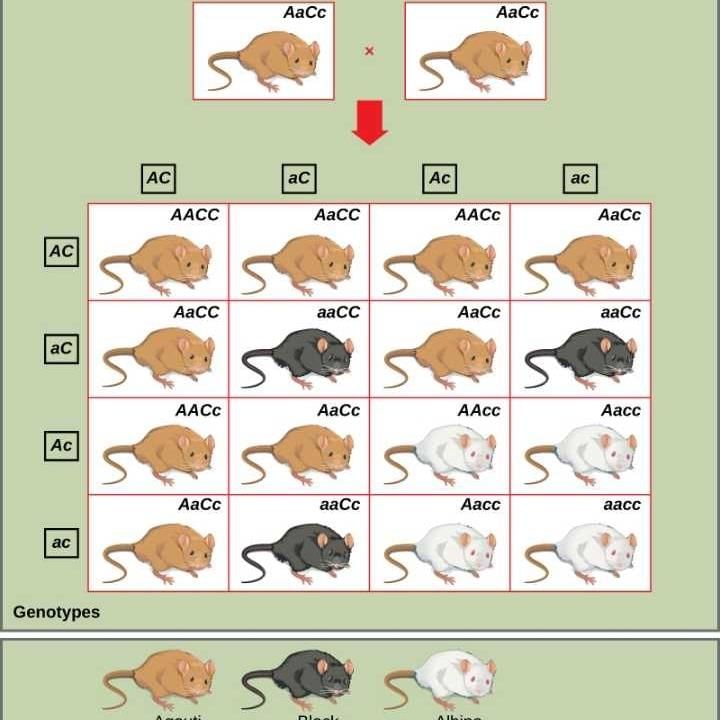NEET Exam > NEET Questions > Skin colour in mice is an example of –a...
Start Learning for Free
Skin colour in mice is an example of –
- a)recessive epistatis
- b)dominant epistatis
- c)polygenic inheritance
- d)pleiotropy
Correct answer is option 'A'. Can you explain this answer?
Most Upvoted Answer
Skin colour in mice is an example of –a)recessive epistatisb)dom...

Community Answer
Skin colour in mice is an example of –a)recessive epistatisb)dom...
Epistasis” is a word composed of Greek roots meaning “standing upon.” The alleles that are being masked or silenced are said to be hypostatic to the epistatic alleles that are doing the masking. Often the biochemical basis of epistasis is a gene pathway in which expression of one gene is dependent on the function of a gene that precedes or follows it in the pathway.
An example of epistasis is pigmentation in mice. The wild-type coat color, agouti (AA) is dominant to solid-colored fur (aa). However, a separate gene C, when present as the recessive homozygote (cc), negates any expression of pigment from the A gene and results in an albino mouse . Therefore, the genotypes AAcc, Aacc, and aacc all produce the same albino phenotype. A cross between heterozygotes for both genes (AaCc x AaCc) would generate offspring with a phenotypic ratio of 9 agouti:3 black:4 albino . In this case, the C gene is epistatic to the A gene.
An example of epistasis is pigmentation in mice. The wild-type coat color, agouti (AA) is dominant to solid-colored fur (aa). However, a separate gene C, when present as the recessive homozygote (cc), negates any expression of pigment from the A gene and results in an albino mouse . Therefore, the genotypes AAcc, Aacc, and aacc all produce the same albino phenotype. A cross between heterozygotes for both genes (AaCc x AaCc) would generate offspring with a phenotypic ratio of 9 agouti:3 black:4 albino . In this case, the C gene is epistatic to the A gene.
Attention NEET Students!
To make sure you are not studying endlessly, EduRev has designed NEET study material, with Structured Courses, Videos, & Test Series. Plus get personalized analysis, doubt solving and improvement plans to achieve a great score in NEET.

|
Explore Courses for NEET exam
|

|
Similar NEET Doubts
Skin colour in mice is an example of –a)recessive epistatisb)dominant epistatisc)polygenic inheritanced)pleiotropyCorrect answer is option 'A'. Can you explain this answer?
Question Description
Skin colour in mice is an example of –a)recessive epistatisb)dominant epistatisc)polygenic inheritanced)pleiotropyCorrect answer is option 'A'. Can you explain this answer? for NEET 2024 is part of NEET preparation. The Question and answers have been prepared according to the NEET exam syllabus. Information about Skin colour in mice is an example of –a)recessive epistatisb)dominant epistatisc)polygenic inheritanced)pleiotropyCorrect answer is option 'A'. Can you explain this answer? covers all topics & solutions for NEET 2024 Exam. Find important definitions, questions, meanings, examples, exercises and tests below for Skin colour in mice is an example of –a)recessive epistatisb)dominant epistatisc)polygenic inheritanced)pleiotropyCorrect answer is option 'A'. Can you explain this answer?.
Skin colour in mice is an example of –a)recessive epistatisb)dominant epistatisc)polygenic inheritanced)pleiotropyCorrect answer is option 'A'. Can you explain this answer? for NEET 2024 is part of NEET preparation. The Question and answers have been prepared according to the NEET exam syllabus. Information about Skin colour in mice is an example of –a)recessive epistatisb)dominant epistatisc)polygenic inheritanced)pleiotropyCorrect answer is option 'A'. Can you explain this answer? covers all topics & solutions for NEET 2024 Exam. Find important definitions, questions, meanings, examples, exercises and tests below for Skin colour in mice is an example of –a)recessive epistatisb)dominant epistatisc)polygenic inheritanced)pleiotropyCorrect answer is option 'A'. Can you explain this answer?.
Solutions for Skin colour in mice is an example of –a)recessive epistatisb)dominant epistatisc)polygenic inheritanced)pleiotropyCorrect answer is option 'A'. Can you explain this answer? in English & in Hindi are available as part of our courses for NEET.
Download more important topics, notes, lectures and mock test series for NEET Exam by signing up for free.
Here you can find the meaning of Skin colour in mice is an example of –a)recessive epistatisb)dominant epistatisc)polygenic inheritanced)pleiotropyCorrect answer is option 'A'. Can you explain this answer? defined & explained in the simplest way possible. Besides giving the explanation of
Skin colour in mice is an example of –a)recessive epistatisb)dominant epistatisc)polygenic inheritanced)pleiotropyCorrect answer is option 'A'. Can you explain this answer?, a detailed solution for Skin colour in mice is an example of –a)recessive epistatisb)dominant epistatisc)polygenic inheritanced)pleiotropyCorrect answer is option 'A'. Can you explain this answer? has been provided alongside types of Skin colour in mice is an example of –a)recessive epistatisb)dominant epistatisc)polygenic inheritanced)pleiotropyCorrect answer is option 'A'. Can you explain this answer? theory, EduRev gives you an
ample number of questions to practice Skin colour in mice is an example of –a)recessive epistatisb)dominant epistatisc)polygenic inheritanced)pleiotropyCorrect answer is option 'A'. Can you explain this answer? tests, examples and also practice NEET tests.

|
Explore Courses for NEET exam
|

|
Suggested Free Tests
Signup for Free!
Signup to see your scores go up within 7 days! Learn & Practice with 1000+ FREE Notes, Videos & Tests.

























